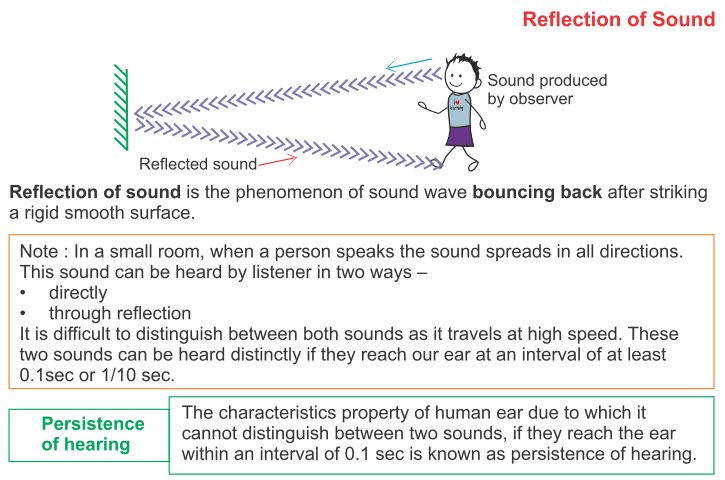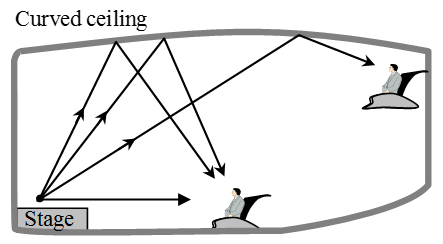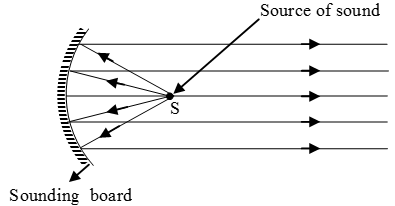Reflection Of Sound

- Sound waves like light waves also get reflected from plane and spherical surfaces. During reflection, sound waves obey the laws of reflections. The reflection of sound from a hard surface can be observed by performing a simple experiment on the equipment as shown in fig.

- Sound waves have much longer wavelength than the light waves. Therefore unlike light waves, sound waves do not need smooth surfaces for suffering reflection. That is why, a brick wall, a wooden board, a row of trees, a hill etc. serve as the reflectors of sound waves.
- To have an appreciable reflection of sound waves from any surface, it should have dimensions equal or larger than the wavelength of the sound waves falling on it. That is, a smaller object will not reflect the sound waves of larger wavelength.
https://www.youtube.com/watch?v=tyK79imjLnk
REVERBERATION
The repeated reflection that results in the persistence of sound in a large hall is called reverberation.

Excessive reverberation in any auditorium/hall is not desirable because the sound becomes blurred and distorted. The reverberation can be minimised/reduced by covering the ceiling and walls with sound absorbing materials, such as, fiber-board, rough plaster, draperies, perforted cardboard sheets etc.
Practical Applications Of Multiple Reflection Of Sound

Some simple devices based on multiple reflection of sound are,
- Stethoscope
- Megaphone, Loudhailer, Horns
- Trumpet, Shehanais
- Curved ceiling of concert hall/conference hall/cinema hall
- Soundboards
Stethoscope: Stethoscope is a medical diagnostic instrument based on multiple reflection of sound waves. This is used by doctors for listening to the sounds produced inside the body, particularly in the heart or lungs.

Megaphone: Megaphone is a horn-shaped tube. Megaphones are used for addressing a small group of people.
Speaking tube is a hollow tube– one end is the speaker’s end, whereas the other one is the listener’s end.
In these devices, the sound waves suffer reflection repeatedly and the energy of the waves remains confined to the tube. The sound waves are prevented from spreading out.

It is for this very reason that loudspeakers also have horn-shaped opening.
Ear Trumpet (or Hearing Aid): Ear trumpet or hearing aid is used by the persons who are hard of hearing. The sound waves received by the wide end of the trumpet are reflected into a much narrower area, leading it to the ear. This increases amplitude of the vibrating air inside the ear and helps in improving hearing.
Sound Boards and Curved Ceiling and Walls in Large Halls: The arched ceiling and walls of large halls or auditorium often reflect the sound waves. These reflected sound waves interfere with the words of the speaker. This problem is solved by hanging curtains, putting up screens or by using sound boards. A sound board is often a concave rigid surface. The speaker is located at the focus of the sound board placed behind the speaker. The sound board the reflected sound waves parallel. This enable the sound to reach large distances.

The sound board prevents the spreading out of the sound waves in different directions.
